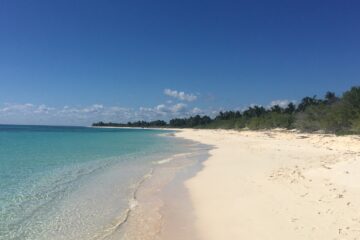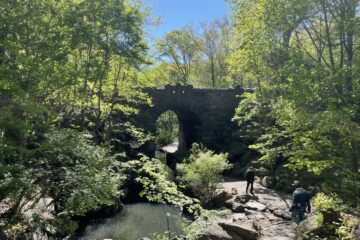A 17-day itinerary, including a visit to eSwatini and Kruger, with options to make it your own!
A few years ago, I first heard about the Bazaruto Archipelago – a stunning set of islands off the coast of Mozambique, home to the last viable dugong population of East Africa. Drone shots of white dunes and turquoise waters hiding these majestic creatures ignited a dream that in autumn 2024, finally came true. Along the way, we explored Mozambique’s southern region, visited Eswatini (formerly Swaziland), and spent time at Kruger National Park in South Africa. Read on for my 17-day itinerary, plus tips on how to make the most of this incredible journey.
Mozambique is a large country, and this itinerary involves long drives. If you’re not keen on driving long distances, you can start your trip in Maputo and/or fly to the Bazaruto Archipelago. However, we recommend minimizing short-distance flights when possible to reduce your environmental impact. Keep in mind that the weather and water conditions in Mozambique can be unpredictable, so be ready to stay flexible with your plans.
Here you can find a condensed itinerary. Read about our experiences on the trip and practical tips further down!
Day 1 – Arrival Johannesburg, pick up the car and stay in Jo’Burg (or drive to Eswatini right away)
Day 2-3 – Drive to eSwatini and explore Mlilwane Game Sanctuary
- Driving time
- Activities
5h / 360 km
Spot wildlife by bike, hike the Hippo Trail
Day 4 – Drive to Praia do Bilene
- Driving time
- Activities
7h / 400 km
Rent a kayak and float around on the lake, drive to the whale watching viewpoint
Day 5-7 – Drive to and explore Tofo
- Driving time
- Activities
6h / 400 km
Dive, snorkel and surf, go on a day-trip to pig and or pansy island, do an ocean safari to look for whales
Day 8-11 – Drive to and explore Vilanculos and the Bazaruto Archipelago
- Driving time
- Activities
5h / 320 km
Dive and snorkel at 2 mile reef, visit Bazaruto and Benguerra, or the Sanctuary, do a seahorse snorkelling trip
Day 12-13 – Drive to Xai Xai and Massingir Dam
- Driving time
- Activities
10h / 750 km
Hike through the sand dunes, explore local towns
Day 14-16 – Drive through Limpopo National Park to Kruger National Park
- Driving time
- Activities
3h / 120 km (to first camp in Kruger)
Drive around Kruger to spot wildlife, do a morning and night safari to explore in the dark and nocturnal wildlife
Day 17 – Drive back to Johannesburg
- Driving time
- Activities
6h / 470 km
Looking out the window
Do you have more time? Explore the beautiful sights and vistas of Blyde River Canyon for a day or two after you’re done in Kruger. The Three Rondavels, Bourke’s Luck Potholes and God’s window are out of this world.
Practical information We rented a car, crossed several borders, tried different foods, used multiple currencies, stayed at multiple campsites and lodges, all in one holiday. I’ve compiled useful travel tips and options for accommodation and activities in separate blogs for both South Africa and eSwatini, and Mozambique. Make sure to check it out!
Day 1: Acquiring a car
After a comfortable flight from the Netherlands to South Africa, we arrived in Johannesburg in the afternoon. We immediately felt the comfortable warmth, even though South African winter was just coming to a close. As the day was almost over, we chose to stay at a hotel near the airport (and the car rental place) and pick up our car the next day.
Travel tip: Make sure to read my post on renting a car in South Africa and driving in Mozambique for information on how to safely get around.
Day 2-3: Off to country #2
Despite only being in South Africa, we already moved on to the next country after one night. We rented a 4×4 at Britz, with a rooftop tent and camping equipment. Because of the equipment, the rental process took quite some time. When all was approved, we drove off, just to stop 200 m further down the road to get some groceries.
Driving to eSwatini and Mlilwane Game reserve went pretty smoothly (read about the border control here). I was surprised by the vast landscape of South Africa and the similarity to the forests of Eastern Europe. I even had flashbacks to Australia as we drove past Eucalyptus forests. Eucalypt is a popular forestry species in South Africa and, as an exotic/non-endemic species originating from Australia, has unfortunately become an unwanted dweller in the South African countryside.
Once we were in country #2, the landscape as well as traffic changed. We were winding through a mountain range with lots of towns, and lots of people on the road. We arrived in the game reserve just before sundown, and were greeted by wildlife. I saw my first antelopes and zebras and felt my enthusiasm rising. We finally were surrounded by the African nature I was craving.
Travel tip: Mlilwane Game reserve is the only reserve in Eswatini where you can walk around without a guide, as there are no big predators in the area (except for the occasional leopard). A unique safari experience in my opinion!
Day 4-7: Sandy beaches and blue waters
After a short and sweet safari experience, we drove all the way to Praia do Bilene which was pretty much deserted as we were in the off-season. We luckily found one campsite that was open, but had to go off-road and through the sand to get there. Good thing we had the 4×4.
We only stayed in Bilene for one night, because Tofo is the place to be. This lively town is known as a popular surfing destination for South Africans, and that’s indeed what we found. The diving was also supposed to be incredible, but we had to wait until our last day to actually experience it because the weather was too stormy before. It was worth the wait though, with lots of beautiful marine wildlife we hadn’t seen before, including the rare shovelnose guitarfish.
Another interesting experience was a day-trip to Pig island. Everything went ‘on African time’ as we were picked up at 7am, but only actually got started at 3 hours later as our guide still had to: pick up water and snacks, get the captain, find a boat, and ultimately change boat and captain last minute and drive somewhere else. All while we were waiting in the car. Then we waited another hour on the boat, as the tide was not right to get to the island and the seahorse snorkelling spot. All worth it though, because we got to see a seahorse (holding on for dear life to a blade of seagrass) and saw how local islanders lived.
Travel tip: Be patient and flexible. Both the tide and the local culture may influence whether or not, and how, an activity will go. All part of the travel experience though! Make sure to always have sunscreen and talk the time to (try to) chat to the guides or locals. Using a translator app has helped us create a connection many times.
Day 8-11: Time for the main event
Picture this: you’re sitting on a deserted beach, with sand dunes behind you and an ocean with 7 different shades of blue in front. You just spotted a rare dugong and a few local boys are now playing with the camera on your phone. In a bit, you’ll be swimming with sharks and turtles in the clearest water you’ve ever experienced at a two-mile long reef. This magical day happened to me in Vilanculos, and can happen to you.
Seeing a dugong in the wild had been on my list for a long time. While the sighting was short, the whole experience was unforgettable. Another incredible wildlife activity was our seahorse snorkelling trip with ParCo, a local conservation project. They work with local fishermen to make their fishing methods more sustainable and help protect the several seahorse species that inhabit the coast. A great afternoon with our faces in the water trying to separate seahorse from seagrass, all the while supporting a valuable local conservation project.
The tropical paradise that is Vilanculos (or Vilankulo) is an interesting mix of high-end tourism versus untouched local living. We joined an unnecessarily expensive sunset tour to the red dunes one night, and had dinner in a grass hut where power went out the other night. The local market people were surprised when they saw us roam around, but there were plenty of tourists at the dive shop.
Travel tip: There is a giant Baobab tree at Baobab Beach hotel/lodge/campsite. We camped right in front of it, but it is definitely also worth a visit (and a hug) if you’re staying somewhere else.
Day 12-13: Just drive
Now that our ‘beach holiday’ was over, it was time for a savanna adventure. To get there, we needed to do lots of driving. All the way from Vilanculos to Kruger, via Massingir Dam and Limpopo National Park. We had an overnight stay in Massingir Dam, because we wanted some time to explore Limpopo NP. To be honest, I would recommend just continuing driving (from Xai Xai all the way to Kruger). The roads in Limpopo NP are truly awful, even with a 4×4. Two of the two cars we encountered in the park ended up with flat tires (we ended up with one of the drivers on our roof to take him to a place with a signal). Limpopo NP also has a lot more dense vegetation, so all things considered you can better spend your time in Kruger.
Day 14-16: Safari time
After only 20 minutes in Kruger National Park, we already stumbled upon a giant herd of elephants. I was in awe of these gentle giants and intrigued by the situation that was unfolding. The elephants were at a watering hole, and there seemed to be a line. Zebras and impalas were waiting on the elephants to finish. But the elephants took their sweet time ofcourse. This was not the only wildlife sighting during our first afternoon in Kruger. We saw plenty of giraffes, wildebeest, zebras and even hyenas and lions.
Kruger is all about animals. We stayed in two different camps to cover as much ground in the park as possible, in the hopes to see as many different species as we could. In only three days, we saw the big 5 and big 7, more elephants, impalas and giraffes than we could count and many different birds I didn’t know the name of (yet). It was the ultimate end to our southern African wildlife trip and I ended up falling in love with the African Savanna.
Where to stay? We were very happy that we rented a 4×4. This allowed us to stay at campsites along the beach. It was relatively hard to find information on accommodation online, but I recommend using Google Maps as a way to find campsites or lodges. I highly recommend renting the Suzuki Jimny with a rooftop tent and staying at Baobab Beach lodge, next to the majestic baobab tree. They also have amazing pizzas there, just so you know. Check out my blog about Mozambique for tips on accommodation.
How to get around? Having a car is highly recommended, as buses in Mozambique are not the most comfortable (or safe) for long distances. But it is doable if that’s the way you want to go! [LINK to blog from girl about public transport]. For South Africa and eSwatini having a car is a must as well, for both safety and flexibility. Read my blogs about car rental and driving in South Africa and Mozambique to learn more.
Did this guide inspire your adventure? Share it with your travel buddy and start planning your trip to Mozambique and beyond!



0 Comments